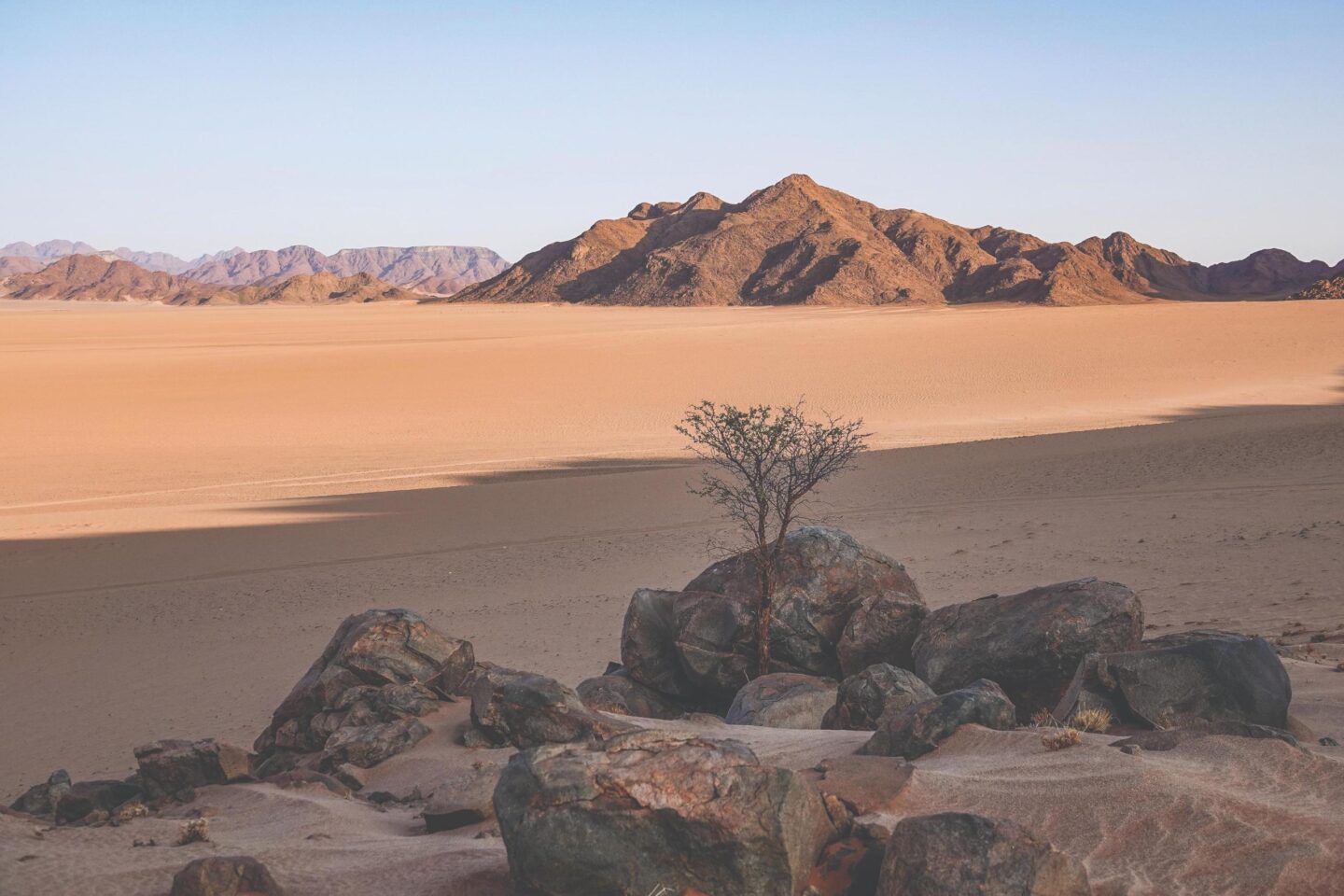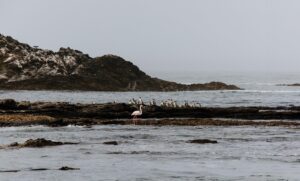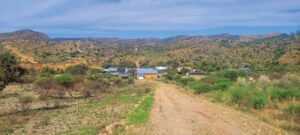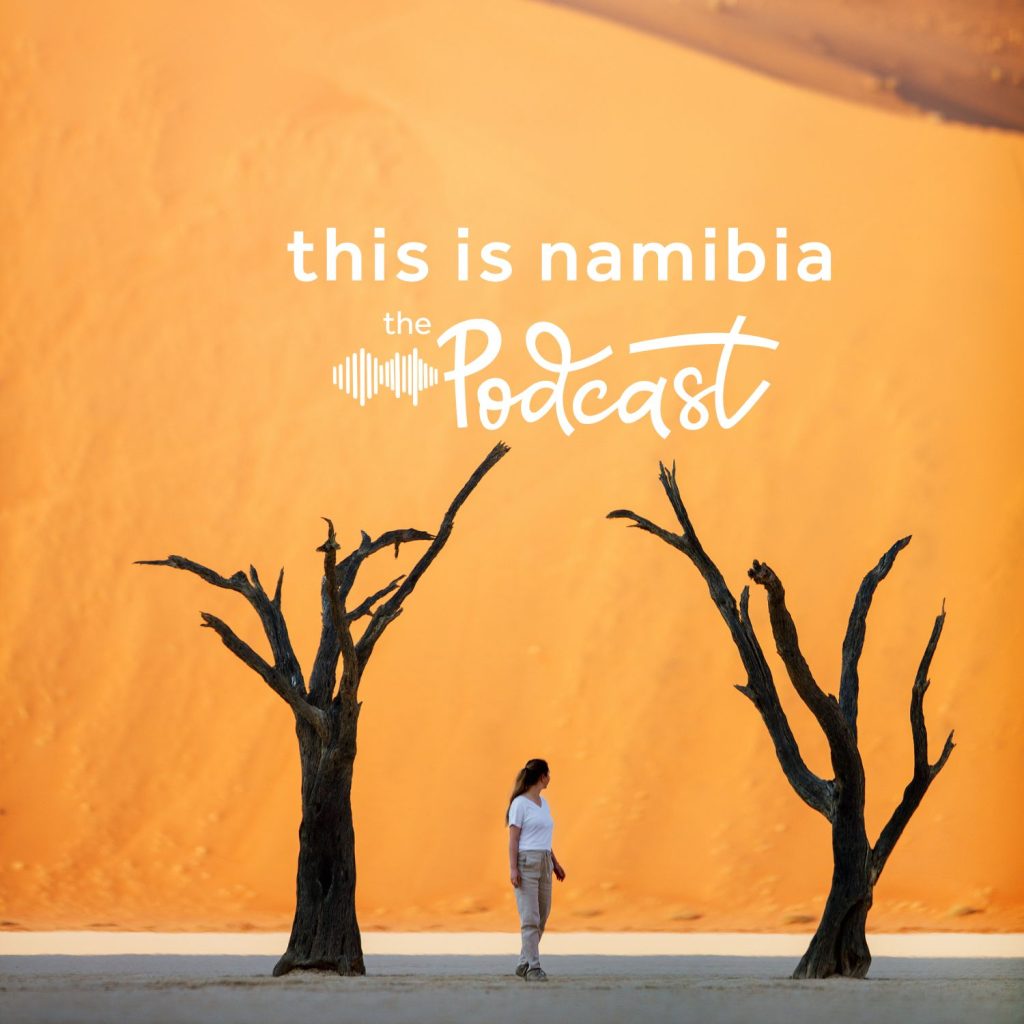

The desert symphony
Rehabilitating landscapes where every detail matters
Text Kirsty Watermeyer | Photographs Kirsty Watermeyer
From the ITB 2025 issue
As I gaze upon the land from a distance, the vastness of the Namib stretches out endlessly before me. Up close, the landscape is an amalgamation of gravelly sand, tufts of dried grass and the stark silhouettes of blackened mountains. Somehow, these simple elements of nature harmonise in perfect balance.
It is in the seamless orchestration of all these elements that the beauty is found. Much like a symphony where each note finds its place in a greater whole. In the desert, every individual detail is crucial to the song it sings collectively.
Even the smallest creatures, like the Namib Desert beetle – also known as the “toktokkie” or “head-stander beetle” for its unique method of collecting water – play a crucial role in the ecosystem. They feed on decaying matter, recycle nutrients and contribute to soil health. If you were to remove them, despite their minute size, it would have far-reaching effects on other species who feed on them, disrupting the entire system.
And then there is the other dimension to this land, the one that reveals itself in moments of raw, breathtaking power. A sandstorm sweeps across the plains, transforming the landscape into something almost otherworldly. The wind moves the sand like brushstrokes on a canvas, creating sweeping zebra stripes of golden dunes across the barren gravel plains. It is a mesmerising, mind-blowing display of nature’s force – chaotic yet beautiful.
THE SUM OF ITS PARTS
The Namib Desert is a finely tuned ecosystem, where everything plays a vital role in maintaining the balance of the delicate web; a harmony that can easily be disrupted. I travelled to the Kulala Wilderness Reserve to witness this complexity and have a look at the Kulala Rehabilitation Project which is aimed at restoring the landscape – once fragmented and fenced farming land – to its original state. This restoration project is not just an act of environmental stewardship, but a deeper recognition of the profound interconnectedness of all life in this remarkable landscape.
My home during this visit was Wilderness Kulala Desert Lodge, a warm, family-friendly retreat that offers an immersive desert experience. With its laid-back atmosphere, the lodge invites you to relax and truly connect with the rugged beauty of the surrounding landscape.
The staff went above and beyond to make our stay memorable, even providing us with a personalised map highlighting recommended routes when they learned we were driving there ourselves. It is the thoughtful, small touches like these that made the experience feel extra special. And then there is the dining – some of the freshest, most delicious food I have had, served under the vast desert sky, followed by stories of the land shared around a crackling campfire.
While every moment at this luxurious lodge was a pleasure, it sparked within me a deeper curiosity about the finer details of the rehabilitation project underway here.
THE KULALA REHABILITATION PROJECT
Eager to learn more upon my return, I sat down with the Wilderness Namibia Impact Team to gain further insight into their vital work. Hamish Hofmeyr, operations manager, Gerhard Thirion, environmental officer, and Dr Conrad Brain, sustainability and conservation officer, regaled me with stories which added an even deeper layer to what was already an incredibly rich and multi-faceted narrative.
According to Thirion, “Kulala is part of a bigger picture within the entire ProNamib, which has been rehabilitated to a point where it became how it used to be.” The ProNamib Nature Reserve is a large-scale conservation project aimed at restoring nature in Namibia’s desert landscape.
In arid conditions, wildlife must be able to move freely to access food and water sources, especially during periods of severe drought. The restoration of the natural migration corridors is critical for the survival of desert-adapted species.
Hofmeyr explains, “The goal was to restore the natural behaviours of these species. Animals like gemsbok, for example, may travel many kilometres in search of food and water. Without access to these migration routes, they would have nowhere to go, and the population would decline significantly.” In the Namib Desert, mammals generally lead a nomadic existence, responding to the unpredictable rainfall and food availability by moving between the plains, dunes and the Namib Escarpment.
A HAVEN FOR ENDEMIC SPECIES
The Namib Desert is home to a remarkable array of species, many of which are found nowhere else on Earth. These endemic creatures depend on the fragile balance of the desert ecosystem. Take the Peringuey’s adder, for example – perfectly adapted to its environment, it lies buried in the sand, with its unique eyes positioned on top of its head, waiting for prey to come within striking range.
As Hofmeyr points out, “If there’s rainfall in a five-square- kilometre area, somewhere in the dunes you’ll suddenly find 100 animals in that small space, while around it, there’s absolutely nothing.” Dr Brain further emphasises that the desert is not only home to endemic species but also provides a critical sanctuary for others, such as the Lappet-faced Vulture. This species depends on the Namib’s remote landscapes for safe breeding grounds. “One vulture, tracked over time, has already travelled more than 97,000 kilometres. Remarkably, it returns every year to breed in the very same area where you stayed at Kulala Desert Lodge,” he says.
As overgrazing by small stock was reduced and the composition of grass species improved, a remarkable transformation unfolded within the Namib Desert ecosystem. The return of wildlife, once driven away by habitat degradation, signalled a turning point for the region’s biodiversity.
THE NEGATIVE AND THE POSITIVE IMPACT OF HUMAN ACTIVITY
In this hyper-arid environment, even the smallest disturbances can leave lasting scars, and even the smallest tracks left in the desert’s delicate crust can persist for centuries. As Dr Brain explains, “As soon as you go up in an aeroplane, you can actually see the visual scarring of the landscape.” One of the most damaging activities is off-road driving. Many birds, for example, nest on the ground in these gravel plains, blending in perfectly with their surroundings.
Meanwhile, conscious travel has the power to ensure these places can remain unspoilt. This is deeply tied to the responsible tourism model that Wilderness promotes. By encouraging low-impact, conscious travel, they help sustain both the environment and local communities. Hofmeyr says, “Ultimately, our goal is to help conserve as much land as possible. We use tourism as a vehicle to achieve this. If we don’t conserve these areas, there won’t be anything for future generations to enjoy. And the people who live here will lose the very thing that makes their land so unique.”
As guests visit places like Kulala Desert Lodge, they are encouraged to understand their role in preserving these fragile environments. With sustainable travel at the core of the Wilderness philosophy, the company works diligently to minimise its environmental impact, ensuring that the habitats which travellers come to experience remain intact.
Thirion adds that tourism plays a crucial role in the region’s economy. “Every dollar earned by a staff member in a camp in one of our remote areas sustains about 12 people,” he notes, adding that beyond the economic benefits, tourism can also provide an avenue for education and awareness.
THE PROMISE FOR EXPLORERS, DREAMERS AND WILDLIFE
The Kulala Wilderness Reserve stands as a proud conservation success story, showcasing the positive impact of responsible, low-impact tourism. Through tireless efforts to restore ecosystems and protect the remarkable wildlife that calls this fragile environment home, Wilderness is ensuring that the Namib Desert remains a thriving sanctuary for biodiversity. Over the years, careful and sustainable management has transformed this land into a flourishing habitat where endemic species can once again thrive. Today, spanning 27,000 hectares, the reserve is home to a rich variety of arid-adapted wildlife. The sensitive landscape has flourished thanks to Wilderness’ ongoing commitment to biodiversity conservation.
The Namib Desert, one of Africa’s most extreme and awe- inspiring landscapes, is home to a unique array of species that have evolved to survive in one of the world’s driest environments. Through their dedication to conservation, Wilderness is playing a pivotal role in preserving this natural sanctuary. As the desert endures, so too does the promise of a living, breathing ecosystem.
The future of these wild places depends on conscious travel, sustainable tourism and the collective efforts of communities, conservationists and visitors alike.
The promise of conscious travel offers hope, not just for today’s explorers, but for the wildlife that will depend on this place in the future. TN
For more information about Wilderness Kulala Desert Lodge, visit: wildernessdestinations.com
More to explore


Discover Airlines launches a new direct flight between Windhoek and Munich




Discover Airlines launches a new direct flight between Windhoek and Munich





